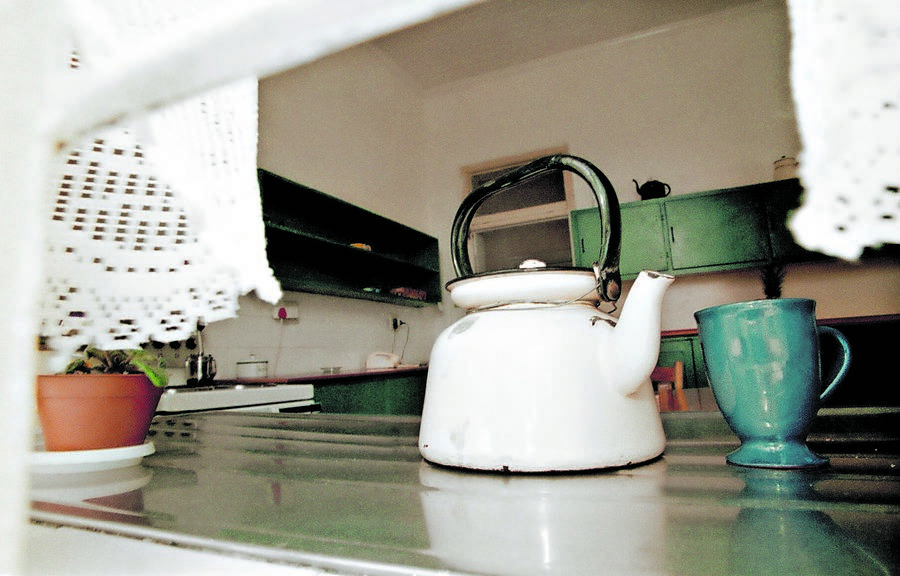Infam-house: The Johannesburg home of South African murderer Daisy de Melker who poisoned her two husbands and her only child in the 1920s.
NOTE: Rhodes is Daisy’s son, who was named after 19th-century British mining magnate and politician in southern Africa Cecil John Rhodes, and the Red Revolt refers to the 1922 Johannesburg miners’ revolt.
The Red Revolt had come dangerously close to the Cowles. On 11 March, at the height of the fighting, the sound of gunfire and bombs ricocheted off the Yeoville ridge behind the small house on Terrace Road.
Barely one mile away, at Ellis Park, 600 strikers had attacked an army depot, leaving eight soldiers and an unknown number of strikers dead. But across the city, the sandbags were soon removed from the fronts of public buildings, shops took off the barricades to stop looting, railway tracks were repaired, trams started running again and residents fell back into their love-hate relationship with the city.
Alfie Cowle returned to work at the municipality as soon as he could, and Daisy to cleaning the house and cooking meals for the family. Rhodes had just turned 11, and would soon be starting senior school. He wasn’t living up to the promise of his name, and was less interested in his studies than in playing football. Maybe if he went to a better school, a private boarding school like Michaelhouse or Hilton College, he would do better. But that was an expense the Cowles couldn’t afford.
In early September, six months after the Red Revolt, Daisy left home one weekday morning after Alfie had gone to work and Rhodes was at school. She caught a bus east to the mining town of Germiston, even though there was a branch of the African Life Assurance Society in the city centre, closer to Terrace Road. She took out a 15-year endowment policy of £100 on the life of Rhodes that would mature in 1933, when he would get £500. The only beneficiary of the policy was Rhodes, unless he died before it matured.
As the Christmas holiday season approached, some of the neighbours noticed it for the first time — Alfie Cowle was not looking well. Ethel Balderow, who lived at number 69 Terrace Road, later recalled him as being unhealthy and deadly pale.
Even though Alfie kept working in the garden, building the wall along the side of the property, things went downhill quickly at the end of 1922. He had been having restless nights, or at least that’s what Daisy told people, although that didn’t keep him away from work the next day. She said she watched him in bed at night as he twitched terribly and breathed laboriously. She wrote to her sister in Kimberley, Fanny McLachlan, that Alfie was “not doing well”.
On Christmas Day 1922, he felt especially poorly, but the Cowles went ahead with their plans anyway. They took the tram from Bertrams to Market Square and then south to City Deep, near their old house on Tully Street, to the home of Selina Poplawski, who had known Daisy from before her marriage. Alfie only pecked at his food, and on the way home he nearly fainted while they were getting off the tram. By the time they reached Terrace Road, he had severe pains in his neck and his back. He thought it was from some medication a friend had given him a few days earlier.
Daisy told Ethel Balderow that Alfie was suffering from some “bad spells”, and warned her that if things got particularly bad, she might come calling for help during the night.
On the morning of 11 January 1923, heavy summer rain came down in sheets against the ridge behind Terrace Road, and for the first time in six months Alfie didn’t go to work. Each time the lightning flashed across the dark sky, it lit up the onion-domed water tower on the ridge like an alien creature out of HG Wells’s The War of the Worlds.
Ethel Balderow heard Rhodes calling over the wall for her to come quickly, and she arrived to find Alfie Cowle in bed, covered in perspiration, his face pressed into a pillow. Other people were there already, as Daisy had raised the alarm in several quarters, telling neighbours, “Come at once, my husband is dying!” Each person in the room, when they were asked about it later on, had noticed something different.
Leonard Bradshaw, who lived across the road and worked with Alfie, arrived first and found him collapsed in a chair, still fully dressed except for a jacket. Asked what was the matter with him, Alfie put his hands to his stomach and said, “God have mercy on my soul.”
Bradshaw’s wife, Frances, arrived next, and saw Cowle foaming at the mouth. After her came Margaret Walker, also from Terrace Road, who saw Alfie with his knees pulled up to his chest and groaning. Balderow, for her part, was struck by the fact that he was clenching his fists, and he seemed to be turning purple in the face. Last to arrive were Emily Stricker, from one road away, and a Miss Williams.
 The kitchen of the house
The kitchen of the house
After a fit of rigidness, lasting only a few moments, Alfie’s body suddenly went limp and then relaxed. Then, quite unexpectedly, it happened again. Daisy tried to give him something to drink, but he refused to take it. If anyone touched him, it increased his pain, and he screamed. He was fearful of anyone even approaching him.
Daisy told some of the visitors that Alfie had been lacing up his boots earlier when she came into the room and saw him fling himself backwards uncontrollably. He had taken some Epsom salts that morning, and she had brought him some tea afterwards because he was thirsty. He believed the Epsom salts had made him feel ill.
After that, his condition quickly worsened. The doctor for the city’s Municipal Provident and Pension Fund, Albert Ernest Hardman Pakes, who had attended to Alfie and Daisy in the past, had been called at eight that morning but was held up. Rhodes then went with a friend to fetch a Dr Leighton, who lived nearby. After Leighton arrived, Alfie had three more convulsions.
When Leighton asked Daisy if her husband had experienced convulsions before, she said he hadn’t but that they were not unlike the convulsions she had witnessed in her four children who had died. Leighton suspected it was some kind of hysterical seizure, but it also reminded him of the shell shock he had seen in returning soldiers. He gave Daisy a prescription for a bromide mixture, which Rhodes took to a nearby pharmacy on Derby Road, while Leighton left to fetch something at home.
While he was gone, the municipal doctor, Pakes, arrived. Pakes found Alfie on the bed in a back room, conscious and lucid, able to speak but afraid to and not letting anyone touch him. A few moments later, he had a violent fit, went stiff, flung his head back and arched his back. After about five seconds he collapsed, limp and exhausted.
 True crime: Ted Botha, author of ‘Daisy de Melker – Hiding Among Killers in the City of Gold’. Photo: Adrian de Kock/Gallo Images
True crime: Ted Botha, author of ‘Daisy de Melker – Hiding Among Killers in the City of Gold’. Photo: Adrian de Kock/Gallo Images
Alfie started telling Pakes that he had taken Epsom salts from a green glass bottle that morning when he was struck by another convulsion, accompanied by a similar arching of the back and throwing back of his head. Pakes thought it might be opisthotonos, a paroxysm of the muscles that causes horrific and unbearably painful backward arching of the head, neck and spine. If he was right, that hardly narrowed down the causes, which could have been cerebral palsy, a traumatic brain injury, hydrocephalus (water pressure on the brain), tetanus, lithium intoxication or, in the final instance, poisoning from strychnine.
Pakes rushed home to fetch some medical instruments. It wasn’t far, but while he was gone Alfred Cowle had another convulsion and died. Someone in the room held a mirror to his mouth to make sure he was not breathing. It was 9.30 am.
When Pakes returned and examined the body, he looked for lockjaw and cerebral haemorrhage, both of them signs of tetanus, but found neither. He asked Daisy about the green bottle of Epsom salts, which she brought to him. Before leaving, he told her that he would not be able to issue a death certificate until she had given the bottle to the police for analysis.
When James Basnett, from the Jeppe police station, arrived at Terrace Road to take Cowle’s body away, no green glass bottle of Epsom salts was mentioned. The body was taken to the government mortuary, where it was received by Dr Basil William Henry Fergus, the acting district surgeon. Without any suggestion that there was something unusual about the death, Fergus began a post-mortem.
He found the meninges were adhering to the brain, below which there had been some haemorrhaging, while the membrane of the stomach was slightly congested. His conclusion was that Cowle had died of a cerebral haemorrhage or chronic nephritis, or Bright’s disease — an inflammation of the kidneys that, as was commonly stated in newspapers, could be fatal. Dr Pakes, upon hearing the results of the post-mortem, assumed that Daisy had followed his instructions to hand in the Epsom salts for analysis, and he accepted Fergus’s findings.
On 12 January 1923, William Alfred Cowle was buried in Brixton Cemetery, not far from the leaders of the Red Revolt. Under the terms of his will, Daisy inherited the house at 67 Terrace Road — the house on Tully Street already belonged to her — and she was paid out £1 245, as well as a further £553 from the Municipal Provident and Pension Fund. At the age of 37, she was suddenly a woman of means, with only one surviving family member, the 12-year-old Rhodes.
Daisy lost no time arranging her new life. She enrolled Rhodes at the best and most expensive school in the country. Hilton College, hundreds of miles away in Pietermaritzburg, was fashioned after traditional English public schools such as Rugby and Eton. The boys educated there came from the wealthiest, most privileged families on the subcontinent, and were almost guaranteed a place in the highest circles of business or politics, sometimes even in England.
She rented out 67 Terrace Road, left her neighbours behind — all the people who had watched Alfie Cowle die — and returned to Tully Street. It is unclear if she moved back into number 22, although it is unlikely. At some stage she became a lodger with one of her old neighbours, Mary Jane Meaker. She started working again on Hospital Hill, at the new Children’s Memorial Hospital, which had just opened. Her duties were more considerable this time, not just the work of a portress but a “theatre portress”, assisting in the operating theatre, which included the cleaning of surgical instruments.
Without anyone to care for at home, she would be able to keep the job longer this time, a full three years. By then, there would also be a new man in her life.